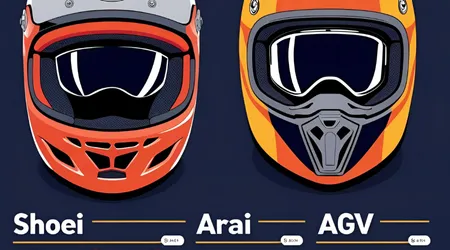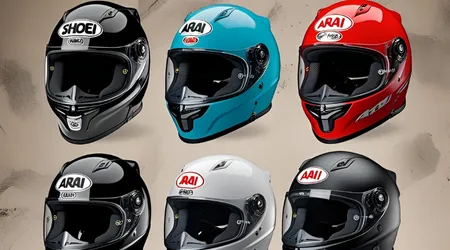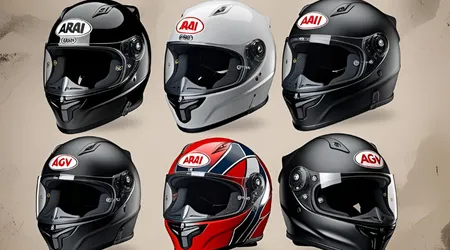Comparing Motorcycle Helmet: Shoei vs Arai vs AGV (Comfort, Safety & Price)
Anúncios
Choosing the right motorcycle helmet is a decision that balances life-saving protection with personal comfort and budget.
With brands like Shoei, Arai, and AGV leading the premium helmet market, riders face a complex choice.
Each brand brings a unique philosophy to the table, shaped by decades of innovation, testing, and real-world performance.
Anúncios
This article dives deep into a comparison of motorcycle helmets from Shoei, Arai, and AGV, focusing on comfort, safety, and price.
Through a blend of technical insights, practical examples, and data-driven analysis, we aim to guide riders toward an informed decision.
Why settle for anything less than the perfect helmet when your safety and riding experience are at stake?
Comfort: Where Fit Meets Function

Comfort in a motorcycle helmet is not just about feeling good; it’s about enhancing focus and reducing fatigue during long rides.
Shoei, Arai, and AGV each prioritize comfort but approach it differently, tailoring their designs to distinct rider needs.
A helmet that fits poorly can distract or even cause pain, undermining the joy of riding.
Let’s explore how these brands stack up in delivering all-day comfort.
++ Tesla Model 3 vs BYD Seal: Which EV Offers More Value in 2025?
Shoei’s approach to comfort is rooted in its “active safety” philosophy, where a comfortable rider is a safer rider.
Their helmets, like the RF-1400, feature customizable EPS liners and cheek pads, allowing riders to fine-tune the fit.
For instance, imagine a cross-country rider named Alex, who spends hours on a touring bike.
Alex swaps out the stock cheek pads in his Shoei Neotec 2 for thinner ones to accommodate his angular face, resulting in a snug, pressure-free fit.
Shoei’s ventilation systems, with multiple intake and exhaust vents, also excel at keeping riders cool, reducing sweat-induced discomfort on hot days.
Additionally, Shoei’s focus on aerodynamics minimizes wind resistance, which translates to less neck strain over long distances.
This attention to detail makes Shoei a favorite for riders prioritizing a tailored, fatigue-free experience.
Arai, by contrast, emphasizes a handcrafted fit, with a focus on accommodating diverse head shapes.
Their helmets, such as the Corsair-X, offer three internal shell shapes round oval, intermediate oval, and long oval ensuring a precise fit for nearly every rider.
Consider Maria, a MotoGP enthusiast with a rounder head shape, who finds Arai’s Quantum-X feels like it was molded for her.
The plush, moisture-wicking liners and strategically placed vents provide excellent airflow, though some riders note Arai’s ventilation is less aggressive than Shoei’s.
Arai’s commitment to handcrafting each helmet ensures consistent padding distribution, which minimizes pressure points.
However, the lack of features like drop-down sun visors, which Shoei offers, might limit convenience for some touring riders.
AGV takes a different tack, blending lightweight design with sporty ergonomics.
The AGV K6-S, for example, uses a carbon-aramid shell to keep weight down, which is a boon for comfort during high-speed rides.
Picture a track-day rider, Tom, who values the K6-S’s featherlight feel at 2.95 pounds, reducing strain during aggressive cornering.
AGV’s Adaptive Fit system, with adjustable padding, allows riders to tweak the interior for a custom feel.
However, some users report that AGV helmets can be noisier at highway speeds compared to Shoei, which might detract from comfort on long rides.
AGV’s wider eyeport also enhances peripheral vision, reducing the claustrophobic feel some riders experience in full-face helmets, making it a strong contender for those prioritizing visibility and weight.
| Brand | Key Comfort Features | Head Shape Fit | Ventilation | Weight (Medium) |
|---|---|---|---|---|
| Shoei | Customizable EPS liners, drop-down sun visors, superior aerodynamics | Intermediate oval | High (multiple vents) | ~3.3 lbs (RF-1400) |
| Arai | Three internal shell shapes, plush liners, handcrafted fit | Round, intermediate, long oval | Moderate | ~3.6 lbs (Corsair-X) |
| AGV | Lightweight carbon-aramid shell, Adaptive Fit system, wide eyeport | Intermediate oval | High | ~2.95 lbs (K6-S) |
Safety: The Core of Protection

Safety is the cornerstone of any motorcycle helmet, and Shoei, Arai, and AGV each bring rigorous standards to the table.
A helmet’s ability to absorb and dissipate impact energy can mean the difference between a minor headache and a life-altering injury.
++ Hybrid SUVs Face-Off: RAV4 Prime vs Hyundai Tucson Plug-in
According to a 2023 SHARP Helmet Safety Scheme study, helmets from these three brands consistently score 4-5 stars in impact tests, with an average rating of 4.2/5 across their premium models.
Let’s unpack how each brand’s safety philosophy translates into real-world protection.
Shoei’s safety approach integrates advanced materials with a focus on rider comfort as a safety enhancer.
Their AIM (Advanced Integrated Matrix) shell combines fiberglass and organic fibers for a balance of strength and flexibility.
The RF-1400, for example, uses a multi-density EPS liner to absorb impacts progressively, slowing down energy transfer to the head.
Shoei’s helmets often meet both DOT and SNELL certifications, with models like the X-Fourteen also passing FIM racing standards.
This makes Shoei a go-to for track riders who need uncompromised protection.
Additionally, Shoei’s podless face shield system reduces wind resistance, minimizing rotational forces during a crash a subtle but critical safety feature.
Arai’s safety ethos is built around its “Glancing Off” design and R75 shell shape, which maintains a continuous 75-degree curve to deflect impact forces.
This design reduces the risk of the helmet catching on surfaces, which could exacerbate rotational injuries.
Arai’s Corsair-X, for instance, is handcrafted with a complex laminate shell, tested to exceed SNELL and DOT standards.
Arai’s refusal to incorporate internal sun visors or modular designs stems from their belief that such features could compromise shell integrity.
This uncompromising stance appeals to riders like professional racers, who trust Arai’s rigorous internal testing.
However, the absence of a SNELL rating in some touring models might concern safety-conscious riders.
AGV’s safety credentials are equally impressive, particularly with its Extreme Safety protocol.
The Pista GP RR, worn by MotoGP legend Valentino Rossi, uses a carbon-fiber shell for exceptional strength-to-weight ratio.
AGV’s helmets meet DOT and ECE standards, with some models like the K6-S achieving high SHARP ratings despite not pursuing SNELL certification.
AGV’s multi-density EPS and wide eyeport enhance safety by improving impact absorption and situational awareness.
However, some riders note that AGV’s lighter shells can feel less substantial in high-impact scenarios compared to Arai’s robust designs.
For example, a rider in a low-side crash at a track day might find AGV’s lightweight construction sufficient, but Arai’s thicker shell could offer extra peace of mind in high-speed tumbles.
| Brand | Safety Certifications | Shell Material | Impact Absorption | Unique Safety Feature |
|---|---|---|---|---|
| Shoei | DOT, SNELL, FIM (select models) | AIM (fiberglass/organic) | Multi-density EPS | Podless face shield |
| Arai | DOT, SNELL (most models) | Complex laminate | Multi-density EPS | R75 Glancing Off design |
| AGV | DOT, ECE | Carbon-aramid | Multi-density EPS | Wide eyeport for awareness |
Price: Value vs. Investment

Price is often the deciding factor when choosing a motorcycle helmet, but it’s not just about the sticker shock—it’s about value over time.
Premium helmets from Shoei, Arai, and AGV command higher prices, but their durability, safety, and comfort justify the investment for many riders.
Let’s break down how these brands compare in terms of cost and what you get for your money.
Shoei helmets typically start at around $480 for models like the RF-SR and can climb to over $900 for premium options like the X-Fourteen with custom graphics.
This price reflects Shoei’s use of high-quality materials and extensive R&D, including wind-tunnel testing for aerodynamics.
++ Tesla Model S vs Porsche Taycan: High-Performance Electric Cars
For a commuter like Sarah, who rides daily in urban traffic, the $600 Shoei GT-Air II offers a drop-down sun visor and modular compatibility, reducing the need for additional accessories.
Shoei’s five-year warranty and crash replacement policy further enhance value, ensuring the helmet remains a long-term investment.
While not the cheapest, Shoei’s balance of comfort and safety features makes it a compelling choice for riders seeking versatility.
Arai’s price points are slightly higher, starting at around $578 for the Defiant-X and reaching up to $950 for the Corsair-X.
The premium reflects Arai’s handcrafted process, where each helmet is assembled by skilled technicians in Japan.
For a touring rider like John, who logs thousands of miles annually, the $700 Arai Quantum-X offers a tailored fit and exceptional durability, lasting up to seven years with proper care.
Arai’s focus on safety and fit customization justifies the cost for riders who prioritize protection over convenience features.
However, the lack of integrated sun visors or modular designs might mean additional expenses for accessories, slightly offsetting the value for some.
AGV offers a broader price range, from $400 for the K1 to $1,925 for the Pista GP RR, making it accessible to both budget-conscious and high-end buyers.
The K6-S, priced at around $670, delivers a lightweight carbon-aramid shell and MotoGP-inspired design, offering premium features at a mid-range price.
For a young rider like Emma, who wants style and performance without breaking the bank, the $400 AGV K1 provides ECE certification and a sporty aesthetic.
AGV’s lower entry-level prices make it attractive for newer riders, though premium models rival Arai and Shoei in cost.
The trade-off is that AGV’s lighter shells may not feel as robust as Arai’s, potentially affecting perceived value in high-stakes scenarios.
| Brand | Entry-Level Price | Premium Price | Warranty | Value Proposition |
|---|---|---|---|---|
| Shoei | $480 (RF-SR) | $900+ (X-Fourteen) | 5 years | Comfort, versatility, warranty |
| Arai | $578 (Defiant-X) | $950 (Corsair-X) | 5 years | Handcrafted safety, fit customization |
| AGV | $400 (K1) | $1,925 (Pista GP RR) | 5 years | Lightweight, style, broad price range |
Motorcycle helmet: Helmets as Armor
Choosing a motorcycle helmet is like selecting armor for a knight heading into battle.
Just as a knight needs armor that fits perfectly, protects vital areas, and allows mobility, a rider needs a helmet that balances comfort, safety, and cost.
Shoei is like a versatile suit of plate armor adaptable and polished, with features that cater to various riding styles.
Arai resembles a meticulously forged samurai helmet, prioritizing protection and tradition over modern conveniences.
AGV, meanwhile, is akin to lightweight chainmail agile and stylish, offering protection with a flair that appeals to speed enthusiasts.
Each “armor” type serves the rider, but the best choice depends on the battle you’re ridingperspective.
Motorcycle helmet: (FAQ)
| Pergunta | Resposta |
|---|---|
| Which brand offers the best safety? | All three brands (Shoei, Arai, AGV) meet or exceed DOT and ECE standards, with Arai and Shoei often achieving SNELL certification. The “best” depends on fit and specific model ratings, with SHARP scores averaging 4.2/5 for premium models across all three. |
| Are AGV helmets more affordable than Shoei and Arai? | Yes, AGV offers lower entry-level prices (e.g., K1 at $400) compared to Shoei ($480) and Arai ($578), but their premium models like the Pista GP RR can be pricier. |
| How do I know which helmet fits my head shape? | Shoei fits intermediate oval heads best, Arai offers three shapes (round, intermediate, long oval), and AGV suits intermediate oval. Try on helmets or consult brand fit guides. |
| Do these helmets come with warranties? | All three brands offer a 5-year warranty, with Shoei and AGV also providing crash replacement policies. |
| Which helmet is best for track riding? | AGV’s Pista GP RR and Shoei’s X-Fourteen are top choices for track due to their lightweight shells and FIM certifications, while Arai’s Corsair-X is favored for its robust safety design. |
Conclusion: motorcycle helmet
Ultimately, the best motorcycle helmets from Shoei, Arai, or AGV depends on your riding style, head shape, and budget.
Shoei excels in versatility and comfort, making it ideal for long-distance riders who value convenience features.
Arai’s handcrafted safety and fit customization appeal to those prioritizing uncompromised protection.
AGV offers a compelling blend of lightweight design and style, perfect for sporty riders on a budget or seeking MotoGP flair.
By weighing comfort, safety, and price, and trying on helmets to ensure a proper fit, you can find the helmet that feels like an extension of yourself on the road.
After all, isn’t your safety worth investing in the best?
